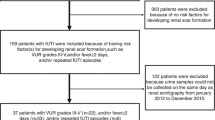Abstract
The aim of this study was to test our hypothesis that the urinary excretion of C-reactive protein (CRP), alpha 1-microglobulin (A1M), retinol-binding protein (RBP) and Clara cell protein (CC16) is increased in children with urinary tract infection (UTI) and relates to renal damage as measured by acute dimercaptosuccinic acid (DMSA) scintigraphy. Fifty-two children <2 years of age with UTI were enrolled in the study, 44 of whom were febrile. The control group consisted of 23 patients with non-UTI infection and elevated serum CRP (s-CRP) levels. Thirty-six patients had abnormal DMSA uptake, classified as mild, moderate or severe damage (DMSA class 1, 2, 3, respectively). There was a significant association between DMSA class and the excretion of urinary RBP (u-RBP) and u-CC16. There was also a significant difference in u-CRP levels between children with UTI and control children with non-UTI infections, although u-CRP excretion was not significantly correlated to DMSA class. In conclusion, the urinary excretion of the low-molecular-weight proteins RBP and CC16 showed a strong association with uptake defects on renal DMSA scans. The urinary level of CRP seems to distinguish between children with UTI and other febrile conditions. A combination of these biomarkers may be useful in the clinical assessment of children with UTI.


Similar content being viewed by others
References
Majd M, Rushton HG (1992) Renal cortical scintigraphy in the diagnosis of acute pyelonephritis. Semin Nucl Med 22:98–111
Carter J, Tomson C, Stevens P, Lamb E (2006) Does urinary tract infection cause proteinuria or microalbuminuria? Nephrol Dial Transplant 21:3031–3037
Sandberg T, Cooper EH, Lidin-Janson G, Yu H (1985) Fever and proximal tubular function in acute pyelonephritis. Nephron 41:39–44
Chiou Y, Chiu N, Chen M, Cheng H (2001) Role of β 2-microglobulinuria and microalbuminuria in pediatric febrile urinary tract infection. Acta Paediatr Taiwan 42:84–89
Jantausch BA, Rifai N, Getson P, Akram S, Majd M, Wiederman BL (1994) Urinary N-acetyl-beta-glucosaminidase and beta-2-microglobulin in the diagnosis of urinary tract infection in febrile infants. Pediatr Infect Dis J 13:294–299
Linné T, Fituri O, Escobar-Billing R, Karlsson A, Wikstad I, Aperia A, Tullus K (1994) Functional parameters and 99mtechnetium-dimercaptosuccinic acid scan in acute pyelonephritis. Pediatr Nephrol 8:694–699
Tomlinson PA, Dalton RN, Hartley B, Haycock GB, Chantler C (1997) Low molecular weight protein excretion in glomerular disease: a comparative analysis. Pediatr Nephrol 11:285–290
Everaert K, Raes A, Hoebeke P, Samijn W, Delanghe J, Van de Wiele C, Van de Walle J (1998) Combined use of urinary α1-microglobulin and 99mTc DMSA scintigraphy in the diagnosis and follow-up of acute pyelonephritis and cystitis in children. Eur Urol 34:486–491
Stokland E, Hellström M, Jacobsson B, Jodal U, Sixt R (1998) Evaluation of DMSA scintigraphy and urography in assessing both acute and permanent renal damage in children. Acta Radiol 39:447–452
Swerkersson S, Jodal U, Sixt R, Stokland E, Hansson S (2007) Relationship among vesicoureteral reflux, urinary tract infection and renal damage in children. J Urol 178:647–651
Jabs WJ, Lögering BA, Gerke P, Kreft B, Wolber EM, Klinger MHF, Fricke L, Steinhoff J (2003) The kidney as a second site of human CRP formation in vivo. Eur J Immunol 33:152–161
Penders J, Delanghe JR (2004) Alpha 1-microglobulin: clinical laboratory aspects and applications. Clin Chem Acta 346:107–118
Piepsz A, Colarinha P, Gordon I, Hahn K, Olivier P, Roca I, Sixt R, Van Velzen J (2001) Guidelines for 99mTc-DMSA scintigraphy in children. Eur J Nucl Med 28:BP37–41
Andersson L, Haraldsson B, Johansson C, Barregard L (2008) Methodological issues on the use of urinary alpha-1-microglobulin in epidemiological studies. Nephrol Dial Transplant 23:1252–1256
Andersson L, Lundberg PA, Barregard L (2007) Methodological aspects on measurement of Clara cell protein in urine as a biomarker for airway toxicity, compared with serum levels. J Appl Toxicol 27:60–66
Hornung RW, Reed LD (1990) Estimation of average concentration in the presence of nondetectable values. Appl Occup Environ Hyg 5:46–51
Wilson AM, Ryan MC, Boyle AJ (2006) The novel role of CRP in cardiovascular disease: risk marker or pathogen. Int J Cardiol 106:291–297
Yasojima K, Schwab C, McGeer EG, McGeer PL (2001) Generation of C-reactive protein and complement components in atherosclerotic plaques. Am J Pathol 158:1039–1051
Ouchi N, Kihara S, Funahashi T, Nakamura T, Nishida M, Kumada M, Okamoto Y, Ohashi K, Nagaretani H, Kishida K, Nishizawa H, Maeda N, Kobayashi H, Hiraoka H, Matsuzawa Y (2003) Reciprocal association of C-reactive protein with adiponectin in blood stream and adipose tissue. Circulation 107:671–674
Foglar C, Lindsey RW (1998) C-reactive protein in orthopedics. Orthopedics 21:687–691
Laiho K, Tiitinen S, Teppo AM, Kauppi M, Kaarela K (1998) Serum C-reactive protein is rarely lost in patients with secondary amyloidosis and proteinuria. Clin Rheumatol 17:234–235
Dillon SC, Taylor GM, Shah V (1998) Diagnostic value of urinary retinol-binding protein in childhood nephritic syndrome. Pediatr Nephrol 12:643–647
Schultz CJ, Dalton RN, Turner C, Neil HA, Dunger DB (2000) Freezing method affects the concentration and variability of urine proteins and the interpretation of data on microalbuminuria. Diabet Med 17:7–14
Tencer J, Thysell H, Andersson K, Grubb A (1997) Long-term stability of albumin, protein HC, immunoglobulin G, kappa- and lambda-chain immunoreactivity, orosomucoid and alpha 1-antitrypsin in urine stored at −20°C. Scand J Urol Nephrol 31:67–71
Author information
Authors and Affiliations
Corresponding author
Rights and permissions
About this article
Cite this article
Andersson, L., Preda, I., Hahn-Zoric, M. et al. Urinary proteins in children with urinary tract infection. Pediatr Nephrol 24, 1533–1538 (2009). https://doi.org/10.1007/s00467-009-1173-2
Received:
Revised:
Accepted:
Published:
Issue Date:
DOI: https://doi.org/10.1007/s00467-009-1173-2




